-
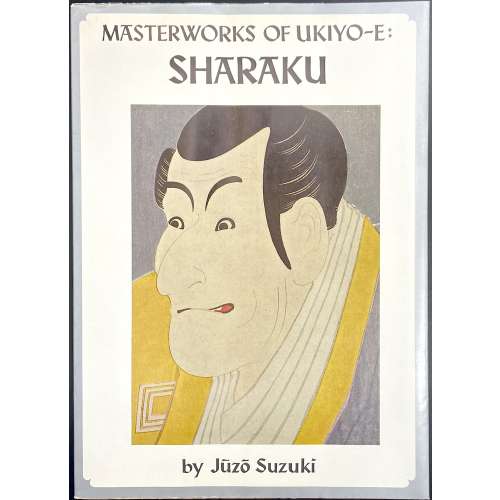 Paperback volume, 25.8 x 18.6 cm, brown embossed wrappers with framed Japanese characters along the outer margin, pictorial dust jacket with series design (black lettering and vignette in silver border to wrappers, black lettering on silver to spine); pp: [1-6]: h.t./frontis. (colour plate pasted in), t.p./imprint, contents/blank), 7-32 text, 33-96 (59 plates w/captions). Title-page (in frame): MASTERWORKS OF UKIYO-E | SHARAKU | by Jūzō Suzuki | Translated by John Bester | {publisher’s device} | KODANSHA INTERNATIONAL LTD. | Tokyo, Japan & Palo-Alto, Calif., U.S.A | {vertical between rules 写楽} || Series: Masterworks of ukiyo-e, № 2. Contributors: Jūzō Suzuki [鈴木 重三] (Japanese, 1919 – 2010) – author. John Bester (British, 1927 – 2010) – translator. Tōshūsai Sharaku [東洲斎 写楽] (Japanese, fl. 1794 – 1795) – artist.
Paperback volume, 25.8 x 18.6 cm, brown embossed wrappers with framed Japanese characters along the outer margin, pictorial dust jacket with series design (black lettering and vignette in silver border to wrappers, black lettering on silver to spine); pp: [1-6]: h.t./frontis. (colour plate pasted in), t.p./imprint, contents/blank), 7-32 text, 33-96 (59 plates w/captions). Title-page (in frame): MASTERWORKS OF UKIYO-E | SHARAKU | by Jūzō Suzuki | Translated by John Bester | {publisher’s device} | KODANSHA INTERNATIONAL LTD. | Tokyo, Japan & Palo-Alto, Calif., U.S.A | {vertical between rules 写楽} || Series: Masterworks of ukiyo-e, № 2. Contributors: Jūzō Suzuki [鈴木 重三] (Japanese, 1919 – 2010) – author. John Bester (British, 1927 – 2010) – translator. Tōshūsai Sharaku [東洲斎 写楽] (Japanese, fl. 1794 – 1795) – artist. -
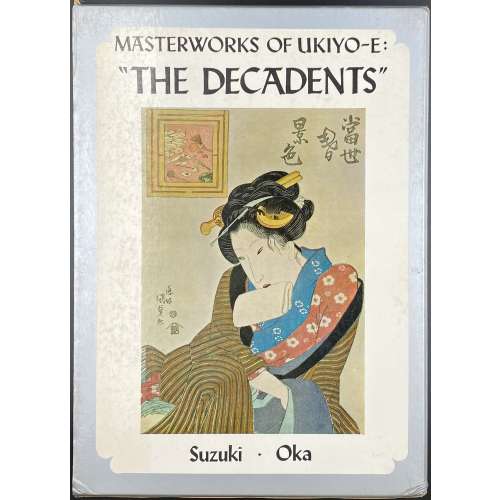 Description: Hardcover 26.5 x 19 cm, grey cloth, red lettering in kanji over black stripe to front, lettering to spine, tan endpapers, pictorial slipcase 27 x 19.5 cm; pp.: [1-6] 7-95 [96], pasted frontispiece and 79 colour illustrations with captions, within a collation. Series Masterworks of ukiyo-e, №8. ISBN: 9780870110986; 0870110985. Ref.: Worldcat Title-page (in frame): MASTERWORKS OF UKIYO-E | "THE DECADENTS” | by Jūzō Suzuki and Isaburō Oka | translation by John Bester | {publisher’s device} | KODANSHA INTERNATIONAL LTD. | Tokyo, Japan & Palo-Alto, Calif., U.S.A. || (Vertical text in kanji to the right, between rules). Artists: Utagawa Kunisada (Japanese [歌川 国貞], 1786 – 1865); Utagawa Kuniyoshi (Japanese [歌川 国芳], 1798 – 1861); Keisai Eisen [Japanese [渓斎 英泉], 1790 – 1848). Contributors: Jūzō Suzuki [鈴木重三] (Japanese, 1919 – 2010) – author. Isaburō Oka [岡畏三郎] (Japanese, 1914 –2010) – author. John Bester (British, 1927 – 2010) – translator Kunisada's fan print in this collection (exactly the same copy) [SVJP-0380.2022]:
Description: Hardcover 26.5 x 19 cm, grey cloth, red lettering in kanji over black stripe to front, lettering to spine, tan endpapers, pictorial slipcase 27 x 19.5 cm; pp.: [1-6] 7-95 [96], pasted frontispiece and 79 colour illustrations with captions, within a collation. Series Masterworks of ukiyo-e, №8. ISBN: 9780870110986; 0870110985. Ref.: Worldcat Title-page (in frame): MASTERWORKS OF UKIYO-E | "THE DECADENTS” | by Jūzō Suzuki and Isaburō Oka | translation by John Bester | {publisher’s device} | KODANSHA INTERNATIONAL LTD. | Tokyo, Japan & Palo-Alto, Calif., U.S.A. || (Vertical text in kanji to the right, between rules). Artists: Utagawa Kunisada (Japanese [歌川 国貞], 1786 – 1865); Utagawa Kuniyoshi (Japanese [歌川 国芳], 1798 – 1861); Keisai Eisen [Japanese [渓斎 英泉], 1790 – 1848). Contributors: Jūzō Suzuki [鈴木重三] (Japanese, 1919 – 2010) – author. Isaburō Oka [岡畏三郎] (Japanese, 1914 –2010) – author. John Bester (British, 1927 – 2010) – translator Kunisada's fan print in this collection (exactly the same copy) [SVJP-0380.2022]: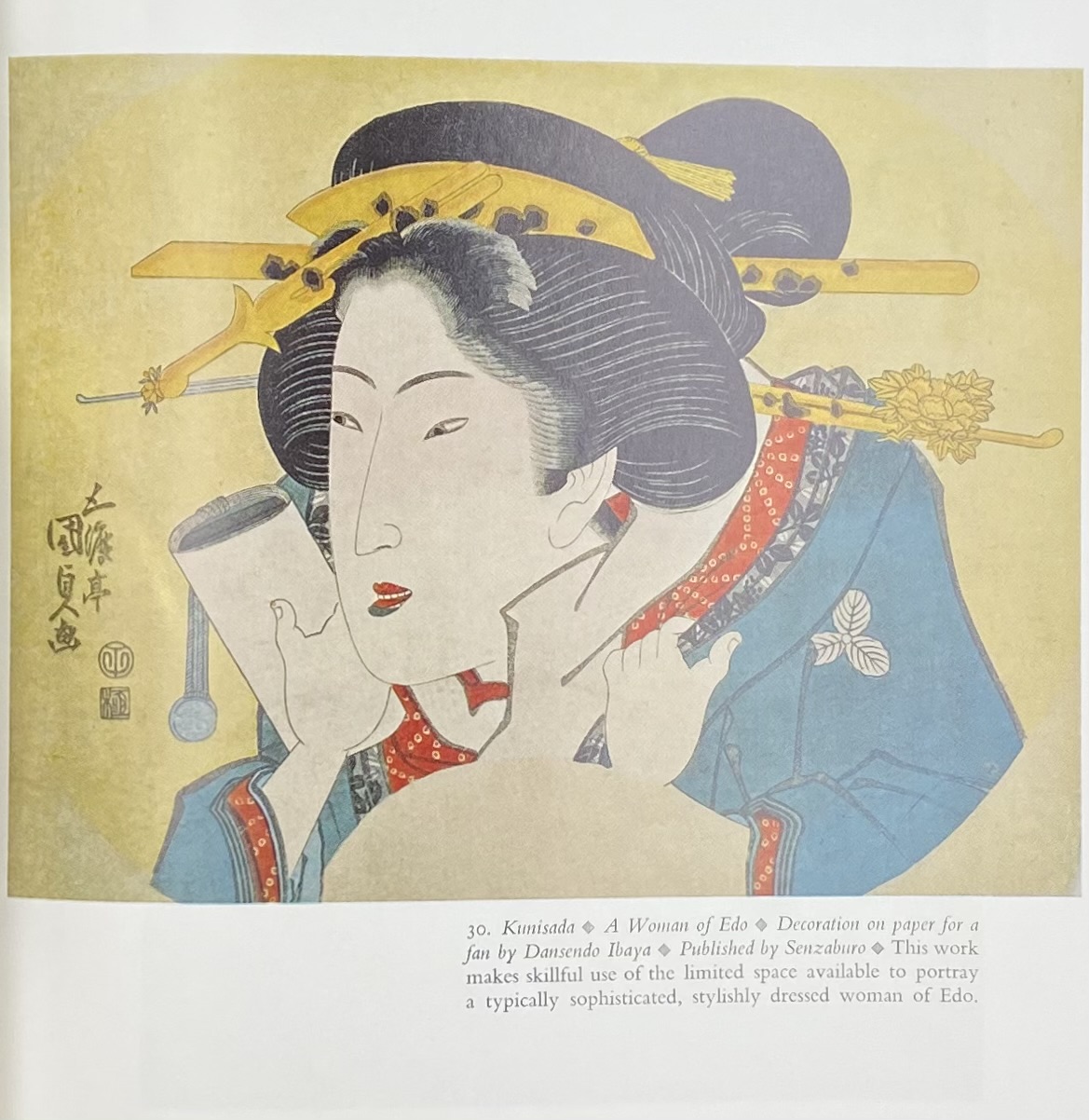
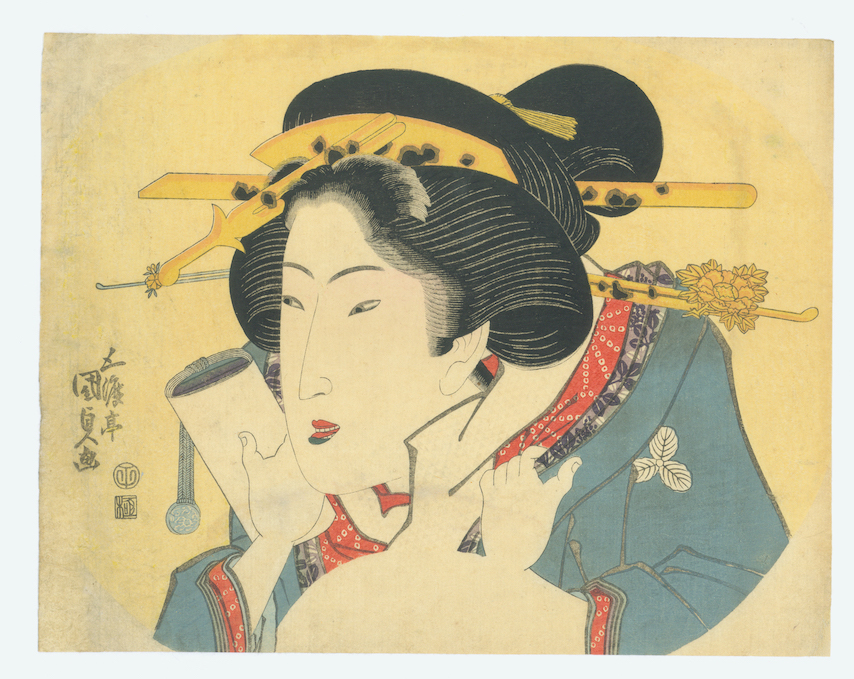
-
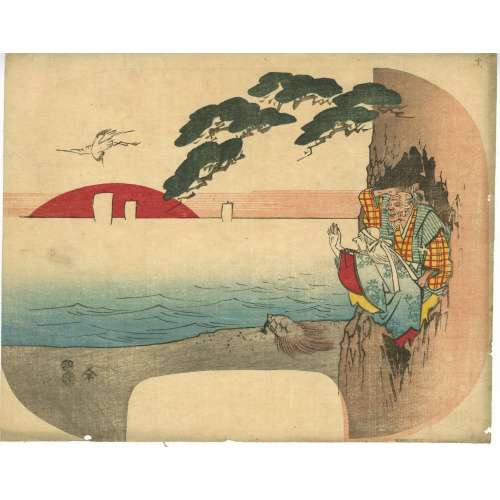 NEWArtist: Attributed to Katsushika Hokusai (葛飾 北斎) (1760–1849) – unsigned. Publisher: Unknown, seal Hei (平); Marks 05-004 | U377a (1848) Censor Seal: Double nanushi Hama (濱) & Kunigasa (衣笠) Date: Kōka 4–5 / Kaei 1 (1847–1848) Media: Rigid fan print (Aiban Yoko-e Uchiwa-e, 合判横絵 団扇絵), 239 × 301 mm The legendary elderly couple Jō and Uba (尉と姥), spirits of the paired pines of Takasago (高砂) and Sumiyoshi (住吉), are known as the Aioi-no-Matsu (相生の松). They symbolize marital harmony, longevity, and the enduring bond of love. The Takasago legend is one of the oldest in Japanese mythology, famously portrayed in the Noh play Takasago no Uta (高砂の歌).
NEWArtist: Attributed to Katsushika Hokusai (葛飾 北斎) (1760–1849) – unsigned. Publisher: Unknown, seal Hei (平); Marks 05-004 | U377a (1848) Censor Seal: Double nanushi Hama (濱) & Kunigasa (衣笠) Date: Kōka 4–5 / Kaei 1 (1847–1848) Media: Rigid fan print (Aiban Yoko-e Uchiwa-e, 合判横絵 団扇絵), 239 × 301 mm The legendary elderly couple Jō and Uba (尉と姥), spirits of the paired pines of Takasago (高砂) and Sumiyoshi (住吉), are known as the Aioi-no-Matsu (相生の松). They symbolize marital harmony, longevity, and the enduring bond of love. The Takasago legend is one of the oldest in Japanese mythology, famously portrayed in the Noh play Takasago no Uta (高砂の歌).Aioi-no-Matsu – The Paired Pines of Takasago and Sumiyoshi
The Aioi-no-Matsu refers to two pine trees growing separately but intertwined at the roots, representing an unbreakable union.- The Takasago pine (高砂の松) grows in Harima Province, while the Sumiyoshi pine (住吉の松) stands in Settsu Province.
- Though physically distant, these trees are spiritually connected, like Jō and Uba, the aged couple who embody their spirits.
- The phrase "The wind that blows through Takasago reaches Sumiyoshi" symbolizes the continuity of love and harmony across time and space.
Aioi-no-Matsu in the Noh Play Takasago
The Noh play Takasago, attributed to Zeami, popularized this imagery.- Jō and Uba appear as an elderly couple raking pine needles, revealing themselves as the spirits of the Aioi-no-Matsu.
- The play conveys the theme of eternal harmony between husband and wife, making Aioi-no-Matsu a symbol of auspicious blessings for weddings and longevity celebrations.
Symbolism in the Print
This print incorporates traditional symbols of longevity and prosperity:- A minogame (蓑亀, "straw-cloaked turtle"), representing immortality, rests near the shore.
- A crane (鶴, tsuru), a symbol of marital fidelity.
- The rising sun over the ocean represents renewal and hope for the coming year.
- Jō and Uba’s presence under the Aioi-no-Matsu (Paired Pines) evokes the traditional New Year’s wish for long life and unity.
- The minogame and crane further reinforce New Year’s themes of prosperity and fortune.
Comparison to MFA Boston Prints
This print shares strong visual and thematic connections with two works attributed to Hokusai in the MFA Boston collection:- Accession No. 21.10269 – "Jō and Uba, the Spirits of the Pine Trees of Takasago and Sumiyoshi"
- Depicts the couple sweeping pine needles, reinforcing themes of domestic harmony and renewal.
- Includes a minogame and a flying crane, similar to this print.
- Accession No. 21.7869 – Another version of "Jō and Uba"
- Shows Jō and Uba standing, gazing at the sea, in a more expansive composition.
- Features a large pine tree, crashing waves, and a red sun, mirroring the background elements in this print.
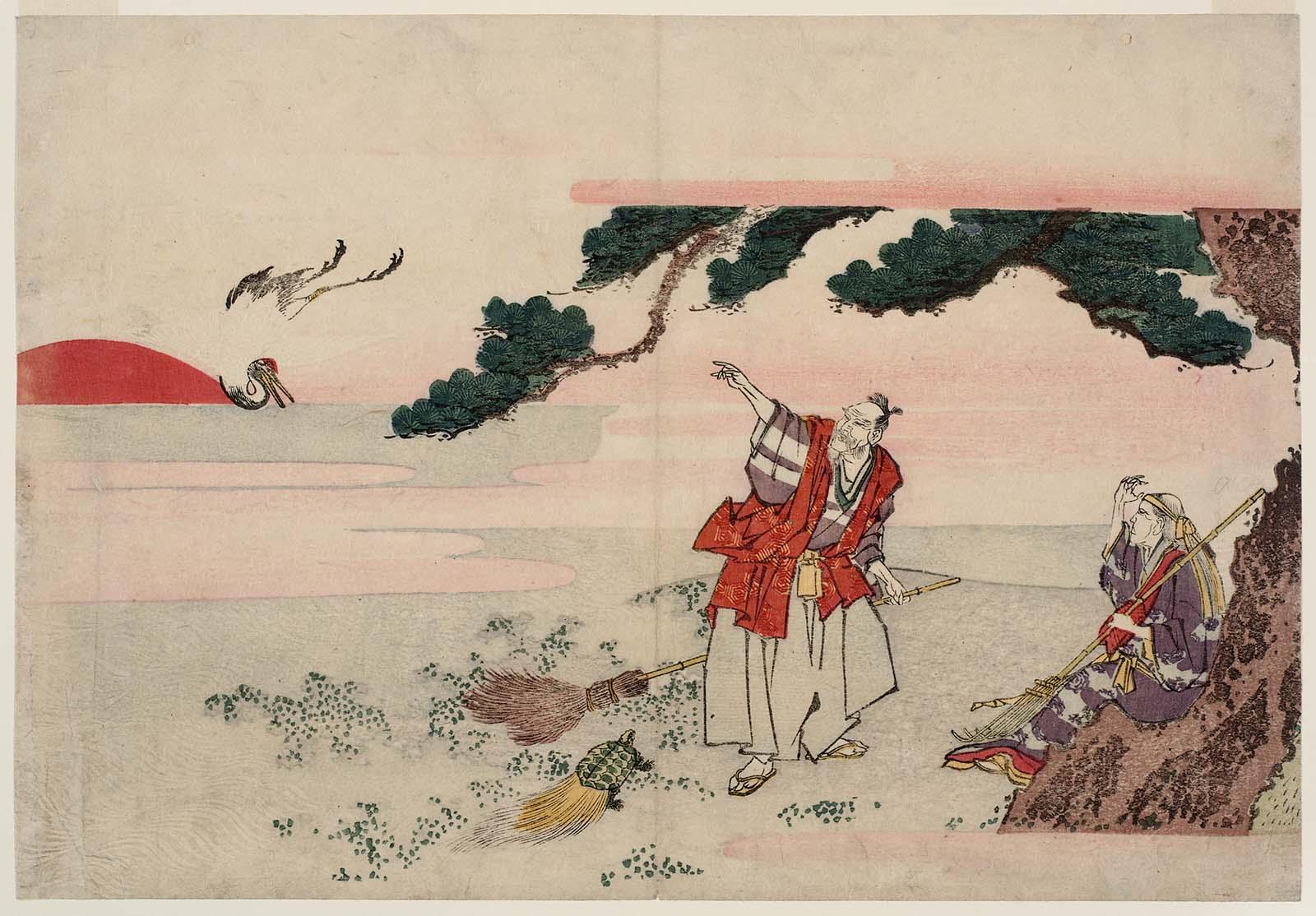
MFA-B № 21.10269
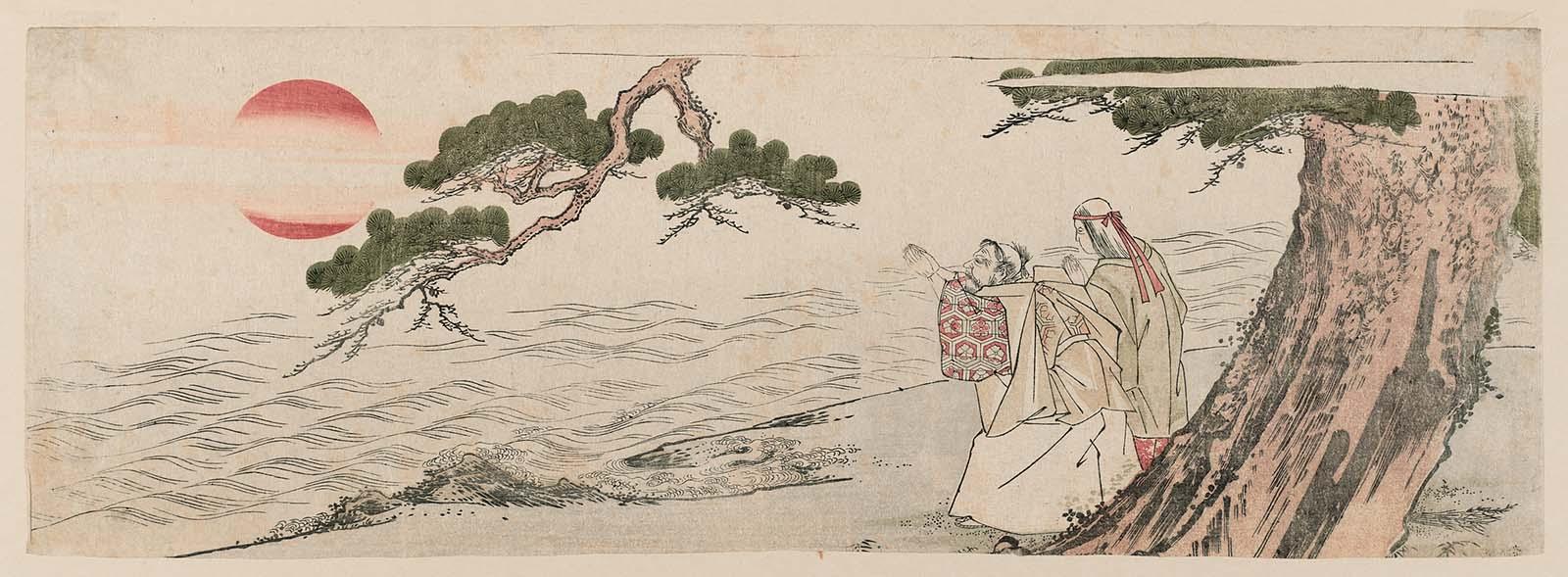
MFA-B № 21.7869
-
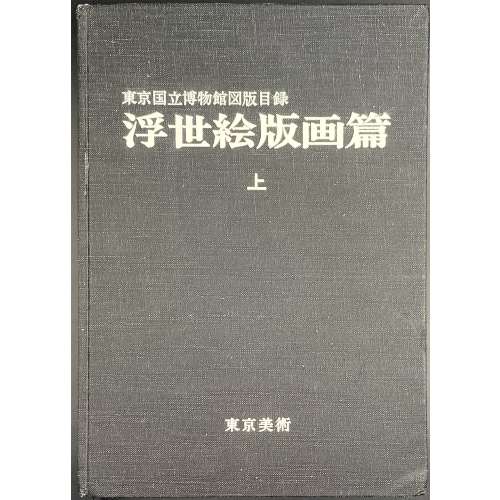 Title: Illustrated Catalogues of Tokyo National Museum: Ukiyo-e Prints [東京国立博物館図版目録 | 浮世絵版画編] (Tōkyō Kokuritsu Hakubutsukan zuhan mokuroku | Ukiyoe hanga hen); Publisher: Tokyo National Museum [東京国立博物館] (Tōkyō Kokuritsu Hakubutsukan). Three volumes, 26.3 x 18.7 cm, uniformly bound in black cloth with white characters to front cover and spine. Title-page: ILLUSTRATED CATALOGUES OF | TOKYO NATIONAL MUSEUM | UKIYO-E PRINTS | <1 (2, 3) > | 東京国立博物館図版目録 | 浮世絵版画編 | < 上 (中, 下) > || Volume 1 [上]: unpaginated 1 t.p., 2 colour plates, 1 contents, 70 (1-1354) – b/w plates, 1 + 48 paginated leaves (1-95 [96]) – text. Volume 2 [中]: unpaginated 1 t.p., 2 colour plates, 1 contents, 67 (1355-2493) – b/w plates + 33 paginated leaves (1-65 [66]) – text. Volume 3 [下]: unpaginated 1 t.p., 2 colour plates, 1 contents, 83 (2494-3926) – b/w plates + 35 paginated leaves (1-69 [70]) – text. Black and white photomechanical reproduction of almost four thousand woodblock prints with titles by the artist and in chronological order.
Title: Illustrated Catalogues of Tokyo National Museum: Ukiyo-e Prints [東京国立博物館図版目録 | 浮世絵版画編] (Tōkyō Kokuritsu Hakubutsukan zuhan mokuroku | Ukiyoe hanga hen); Publisher: Tokyo National Museum [東京国立博物館] (Tōkyō Kokuritsu Hakubutsukan). Three volumes, 26.3 x 18.7 cm, uniformly bound in black cloth with white characters to front cover and spine. Title-page: ILLUSTRATED CATALOGUES OF | TOKYO NATIONAL MUSEUM | UKIYO-E PRINTS | <1 (2, 3) > | 東京国立博物館図版目録 | 浮世絵版画編 | < 上 (中, 下) > || Volume 1 [上]: unpaginated 1 t.p., 2 colour plates, 1 contents, 70 (1-1354) – b/w plates, 1 + 48 paginated leaves (1-95 [96]) – text. Volume 2 [中]: unpaginated 1 t.p., 2 colour plates, 1 contents, 67 (1355-2493) – b/w plates + 33 paginated leaves (1-65 [66]) – text. Volume 3 [下]: unpaginated 1 t.p., 2 colour plates, 1 contents, 83 (2494-3926) – b/w plates + 35 paginated leaves (1-69 [70]) – text. Black and white photomechanical reproduction of almost four thousand woodblock prints with titles by the artist and in chronological order. -
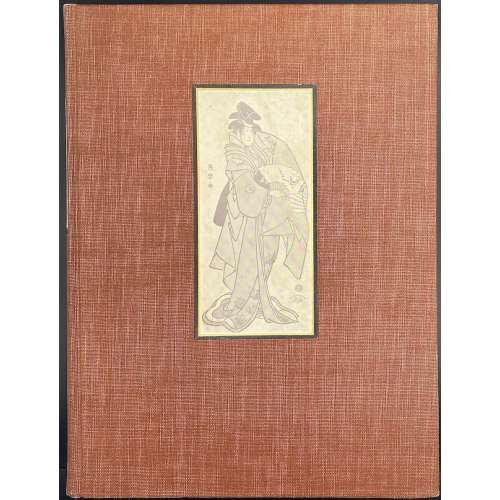 Hardcover volume, 31 x 23.5 cm, bound in full crimson canvas, reproduction colour print with black border pasted to embossed panel, ivory paper label with black lettering to spine, pp.: ffl, [1-4] (t.p./imprint, dedication/blank, 5-337 [338] colophon, 146 b/w woodblock prints by Sharaku photomechanically reproduced, within the pagination. Title-page: THE SURVIVING WORKS OF | SHARAKU | By HAROLD G. HENDERSON | and LOUIS V. LEDOUX | {device} | {blank} | PUBLISHED BY E. WEYNE • NEW YORK | ON BEHALF OF THE | SOCIETY OF THE JAPANESE STUDIES | 1939 || Colophon: PRINTED BY PETER BEILENSON AT THE WALPOLE PRINTING OFFICE | MOUNT VERNON • NEW YORK || Contributors: Harold Gould Henderson (American, 1889 – 1974)– author. Louis Vernon Ledoux (American, 1880 – 1948) – author. Tōshūsai Sharaku [東洲斎 写楽] (Japanese, fl. 1794 – 1795) – artist. Peter Beilenson (American, 1905 – 1962) – printer. Society for Japanese Studies – publisher. Walpole Printing Office (Mount Vernon, NY) – printer
Hardcover volume, 31 x 23.5 cm, bound in full crimson canvas, reproduction colour print with black border pasted to embossed panel, ivory paper label with black lettering to spine, pp.: ffl, [1-4] (t.p./imprint, dedication/blank, 5-337 [338] colophon, 146 b/w woodblock prints by Sharaku photomechanically reproduced, within the pagination. Title-page: THE SURVIVING WORKS OF | SHARAKU | By HAROLD G. HENDERSON | and LOUIS V. LEDOUX | {device} | {blank} | PUBLISHED BY E. WEYNE • NEW YORK | ON BEHALF OF THE | SOCIETY OF THE JAPANESE STUDIES | 1939 || Colophon: PRINTED BY PETER BEILENSON AT THE WALPOLE PRINTING OFFICE | MOUNT VERNON • NEW YORK || Contributors: Harold Gould Henderson (American, 1889 – 1974)– author. Louis Vernon Ledoux (American, 1880 – 1948) – author. Tōshūsai Sharaku [東洲斎 写楽] (Japanese, fl. 1794 – 1795) – artist. Peter Beilenson (American, 1905 – 1962) – printer. Society for Japanese Studies – publisher. Walpole Printing Office (Mount Vernon, NY) – printer -
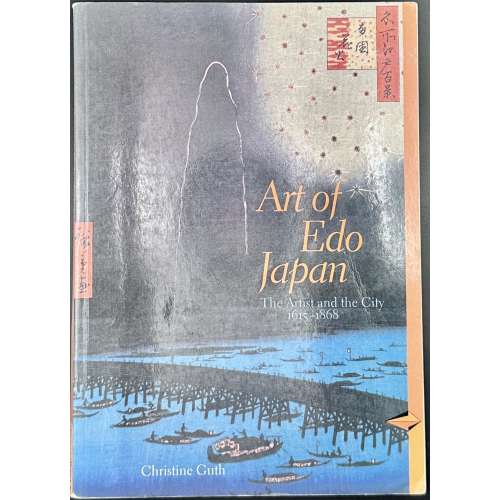 Softcover, pictorial wrappers, 235 x 165 mm, pp. [1-9] 10-176, 120 illustrations, incl. 109 in full colour, 3 maps, glossary, and timeline. An enveloped postcard to E. Varshavsky laid in. Text profusely marked with coloured highlighters. Title-page (pictorial): Art of Edo Japan | The Artist and the City 1615-1868 | Christine Guth | PERSPECTIVES | HARRY N. ABRAMS, INC. PUBLISHERS || Contents: NOTE TO THE READER Map: Japan during the Edo period INTRODUCTION: Mapping the Artistic Landscape
Softcover, pictorial wrappers, 235 x 165 mm, pp. [1-9] 10-176, 120 illustrations, incl. 109 in full colour, 3 maps, glossary, and timeline. An enveloped postcard to E. Varshavsky laid in. Text profusely marked with coloured highlighters. Title-page (pictorial): Art of Edo Japan | The Artist and the City 1615-1868 | Christine Guth | PERSPECTIVES | HARRY N. ABRAMS, INC. PUBLISHERS || Contents: NOTE TO THE READER Map: Japan during the Edo period INTRODUCTION: Mapping the Artistic Landscape- The Artist and the City
- Kyoto Artists
- Edo Artists
- Osaka and Nagasaki Artists
- Itinerant, Provincial, and Rural Artists; Itinerant Monk-Artists and Pilgrimage Art; Poet and Literati Painters; Provincial and Rural Artists


